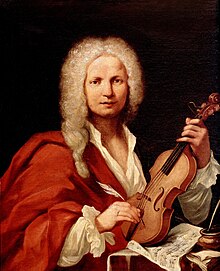
The Four Seasons is a group of four violin concertos by Italian composer Antonio Vivaldi, each of which gives musical expression to a season of the year. These were composed around 1718−1720, when Vivaldi was the court chapel master in Mantua. They were published in 1725 in Amsterdam, together with eight additional concerti, as Il cimento dell'armonia e dell'inventione.

The Mandolin Concerto in C major, RV 425, was written by the Italian composer Antonio Vivaldi in 1725 and is often accompanied by The Four Seasons (1725). The music consists of virtuosic treatment of the solo instrument, the mandolin, and the interplay between the soloist and accompaniment of the orchestra. The demands are considered higher than other concerti by Vivaldi, and the work is one of the most famous mandolin pieces. This concerto has been transcribed for guitar.

L'estro armonico, Op. 3, is a set of 12 concertos for stringed instruments by Italian composer Antonio Vivaldi, first published in Amsterdam in 1711. Vivaldi's Twelve Trio Sonatas, Op. 1, and Twelve Violin Sonatas, Op. 2, only contained sonatas, thus L'estro armonico was his first collection of concertos appearing in print. It was also the first time he chose a foreign publisher, Estienne Roger, instead of an Italian. Each concerto was printed in eight parts: four violins, two violas, cello and continuo. The continuo part was printed as a figured bass for violone and harpsichord.
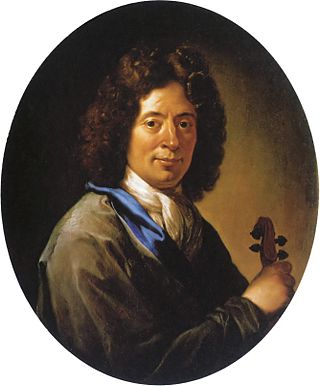
Twelve concerti grossi, Op. 6, is a collection of twelve concerti written by Arcangelo Corelli probably in the 1680s but not prepared for publication until 1714. They are among the finest and first examples of concerti grossi: concertos for a concertino group and a ripieno group of strings with continuo. Their publication – decades after their composition and after Italian composers had moved to favor the ritornello concerto form associated with Vivaldi – caused waves of concerto grosso writing in Germany and England, where in 1739 George Frideric Handel honored Corelli directly with his own "Opus 6" collection of twelve.
A solo concerto is a musical form which features a single solo instrument with the melody line, accompanied by an orchestra. Traditionally, there are three movements in a solo concerto, consisting of a fast section, a slow and lyrical section, and then another fast section. However, there are many examples of concertos that do not conform to this plan.
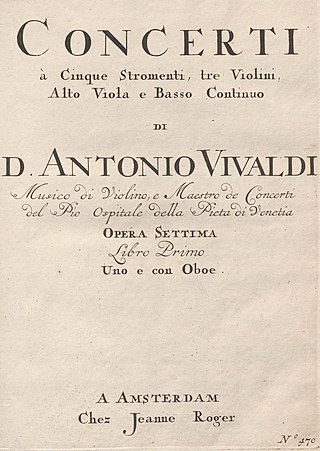
A set of twelve concertos was published by Estienne Roger in 1716-1717 under Antonio Vivaldi's name, as his Opus 7. They were in two volumes, each containing concertos numbered 1-6. Of the set, ten were for violin solo; the other two were for oboe solo. The authenticity of some of the works included has long been doubted by scholars. Three are now considered spurious for stylistic reasons. They are: No. 1 in B-flat major for oboe, RV Anh. 143 ; No. 7 in B-flat major for oboe, RV Anh. 142 ; and No. 9 in B-flat major for violin, RV Anh. 153.

La stravaganza [literally 'Extravagance'], Op. 4, is a set of concertos written by Antonio Vivaldi in 1712–1713. The set was first published in 1716 in Amsterdam and was dedicated to Venetian nobleman Vettor Delfino, who had been a violin student of Vivaldi's. All of the concertos are scored for solo violin, strings, and basso continuo; however, some movements require extra soloists.
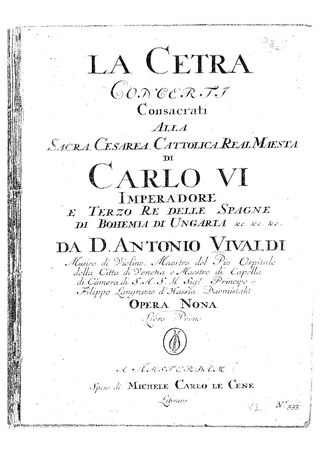
La cetra, Op. 9, is a set of twelve violin concertos by Antonio Vivaldi, published in 1727. All of them are for violin solo, strings, and basso continuo, except No. 9 in B flat, which features two solo violins. The set was named after the cetra, a lyre-like instrument, and was dedicated to Emperor Charles VI.

The keyboard concertos, BWV 1052–1065, are concertos for harpsichord, strings and continuo by Johann Sebastian Bach. There are seven complete concertos for a single harpsichord, three concertos for two harpsichords, two concertos for three harpsichords, and one concerto for four harpsichords. Two other concertos include solo harpsichord parts: the concerto BWV 1044, which has solo parts for harpsichord, violin and flute, and Brandenburg Concerto No. 5 in D major, with the same scoring. In addition, there is a nine-bar concerto fragment for harpsichord which adds an oboe to the strings and continuo.

The Twelve Grand Concertos, Op. 6, HWV 319–330, by George Frideric Handel are concerti grossi for a concertino trio of two violins and cello and a ripieno four-part string orchestra with harpsichord continuo. First published by subscription in London by John Walsh in 1739, they became in a second edition two years later Handel's Opus 6. Taking the older concerto da chiesa and concerto da camera of Arcangelo Corelli as models, rather than the later three-movement Venetian concerto of Antonio Vivaldi favoured by Johann Sebastian Bach, they were written to be played during performances of Handel's oratorios and odes. Despite the conventional model, Handel incorporated in the movements the full range of his compositional styles, including trio sonatas, operatic arias, French overtures, Italian sinfonias, airs, fugues, themes and variations and a variety of dances. The concertos were largely composed of new material: they are amongst the finest examples in the genre of baroque concerto grosso.
The Musette, or rather chaconne, in this Concerto, was always in favour with the composer himself, as well as the public; for I well remember that HANDEL frequently introduced it between the parts of his Oratorios, both before and after publication. Indeed no instrumental composition that I have ever heard during the long favour of this, seemed to me more grateful and pleasing, particularly, in subject.
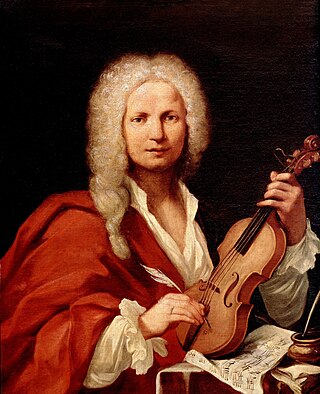
Antonio Vivaldi wrote a set of concerti, Op. 11, in 1729.

Antonio Vivaldi composed several sonatas for cello and continuo. A set of six cello sonatas, written between 1720 and 1730, was published in Paris in 1740. He wrote at least four other cello sonatas, with two manuscripts kept in Naples, another in Wiesentheid, and one known to be lost.
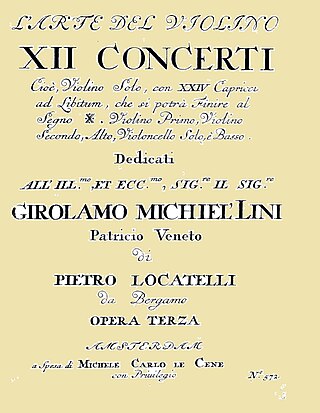
L'arte del violino is a noteworthy and influential musical composition by Italian Baroque violinist and composer Pietro Locatelli. The twelve concerti were written for solo violin, strings, and basso continuo and were published in 1733 as the composer's third opus. The virtuosic style and artistry present in the work strongly influenced violin playing in the 18th century and cemented Locatelli's reputation as a pioneer of modern violin technique.

La tempesta di mare, a flute concerto in F major, is the first of Six Flute Concertos, Op. 10 by Antonio Vivaldi, published in the late 1720s. La tempesta di mare may also refer to two earlier versions of the same concerto, RV 98, a concerto da camera featuring the flute, from which Vivaldi derived the concerto grosso RV 570.
Ugo Orlandi is a musicologist, a specialist in the history of music, a university professor and internationally renowned mandolinist virtuoso. Among worldwide musicians, professional classical musicians are a small group; among them is an even smaller group of classical mandolinists. Among members of this group, Ugo Orlandi is considered "distinguished." Music historian Paul Sparks called him "a leading figure in the rehabilitation of the eighteenth-century mandolin repertoire, having recorded many concertos from this period."
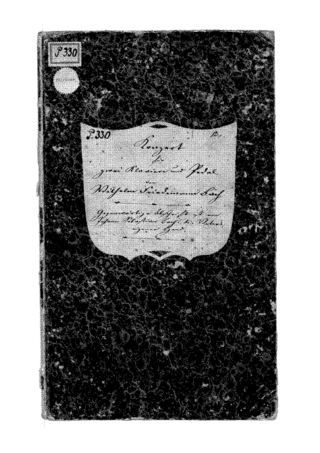
The organ concertos of Johann Sebastian Bach are solo works for organ, transcribed and reworked from instrumental concertos originally composed by Antonio Vivaldi and the musically talented Prince Johann Ernst of Saxe-Weimar. While there is no doubt about the authenticity of BWV 592–596, the sixth concerto BWV 597 is now probably considered to be spurious. Composed during Bach's second period at the court in Weimar (1708–1717), the concertos can be dated more precisely to 1713–1714.

Johann Sebastian Bach wrote his fifth Brandenburg Concerto, BWV 1050.2, for harpsichord, flute and violin as soloists, and an orchestral accompaniment consisting of strings and continuo. An early version of the concerto, BWV 1050.1, originated in the late 1710s. On 24 March 1721 Bach dedicated the final form of the concerto to Margrave Christian Ludwig of Brandenburg.

Grosso mogul, also Il grosso mogul, or capitalised [Il] Grosso Mogul, RV 208, is a violin concerto in D major by Antonio Vivaldi. The concerto, in three movements, is an early work by the Venetian composer. Around the mid-1710s Johann Sebastian Bach transcribed the concerto for organ, BWV 594, in C major. A simplified version of the violin concerto, RV 208a, without the elaborated cadenzas that appear in manuscript versions of RV 208, and with a different middle movement, was published around 1720 in Amsterdam as concerto #11 of Vivaldi's Op. 7.

Antonio Vivaldi's Concerto for Two Cellos in G minor, RV 531 is a concerto for two cellos, string orchestra and basso continuo in three movements, believed to have been composed in the 1720s. It is Vivaldi's only concerto for two cellos, and begins unusually with an entry of the solo instruments alone.

Antonio Vivaldi's Concerto for Two Trumpets in C major, RV 537, is a concerto for two trumpets, string orchestra and basso continuo in three movements, believed to have been composed in the 1720s. It is Vivaldi's only trumpet concerto. It was published by Ricordi in 1950 after its manuscript was found in a Turin library.
